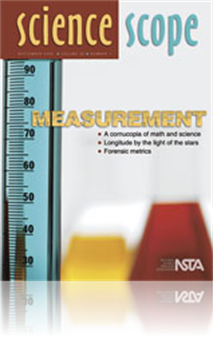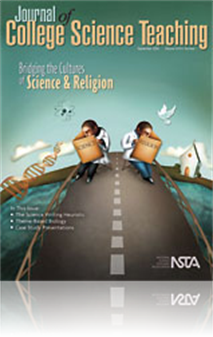All Resources
Journal Article
Most middle-level students are very appearance-conscious, and an accidental spill in the cafeteria can result in a daylong struggle to cover an embarrassing stain. Thanks to the science of nanotechnology, now students can enjoy a slice of pizza witho...
Journal Article
A Message from the NSTA President: Developing a World View for Science Education
In this section, NSTA President Michael Padilla shares a story reflecting the affect that immigration has had on almost all school systems across the country. He shares his motivation for choosing Developing a World View for Science Education as the...
Journal Article
Editorial: Moving On but Staying Around
One of the many benefits of college and university teaching is that it is often possible to remain active in school affairs after retirement. Some elder faculty continue to teach while others participate in research and take part in seminars and col...
Journal Article
Easy Ways to Promote Inquiry in a Laboratory Course: The Power of Student Questions
To teach students to think like scientists, we modified our laboratory course to include regular opportunities for student practice of inquiry and the scientific process. Our techniques are simple; they can be implemented without rewriting lab manual...
Journal Article
Mathematics is said to be the language of science. If this is true, then measurement is certainly the popular language. Since mathematics and science both claim measurement to be integral aspects of their curricula, measurement is a natural beginning...
Journal Article
National School Science Safety Indexing Project: A Beginning
There is extensive agreement within the science profession that the "hands-on, minds-on" approach to teaching and learning described within the National Science Education Standards creates a more effective learning environment. However, inquiry poses...
Journal Article
The trend toward inquiry-based learning is providing today's students with a more enriching education. When implementing inquiry it is important to recognize the great number of safety concerns that accompany this paradigm shift. Fortunately, with so...
Journal Article
Celestial navigation is the process of finding your position on Earth based on astronomical guideposts. In this lesson, explore the principles of navigation; build tools to observe celestial bodies, and learn how science, mathematics, technology, and...
Journal Article
Using the Science Writing Heuristic: Training Chemistry Teaching Assistants
Promoting the use of the Science Writing Heuristic (SWH) among novice teaching assistants at a large university is facilitated by a program of instructional training and mentoring. Sessions include hands-on activities with guided inquiry in tandem wi...
Journal Article
Career of the Month: Foodborne Disease Epidemiologist
Did you know that Salmonella and E. coli are just two of more than 250 different identified foodborne diseases? To Jack Guzewich, a Foodborne Disease Epidemiologist with the Food and Drug Administration's (FDA) Center for Food Safety and Applied Nu...





